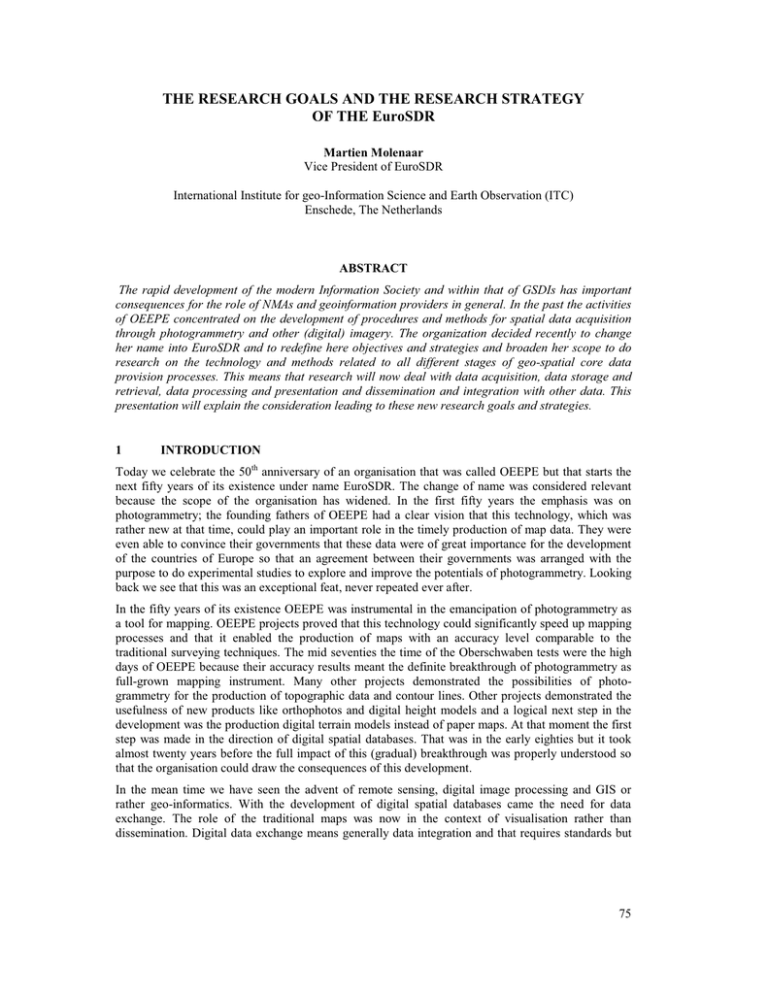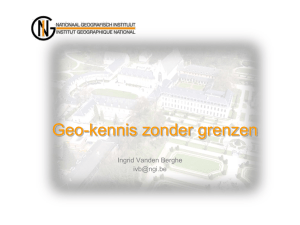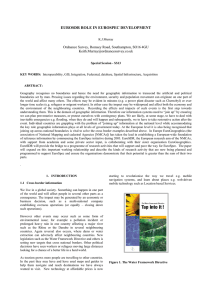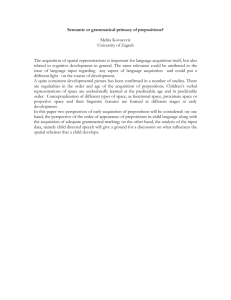THE RESEARCH GOALS AND THE RESEARCH STRATEGY OF THE EuroSDR
advertisement

THE RESEARCH GOALS AND THE RESEARCH STRATEGY OF THE EuroSDR Martien Molenaar Vice President of EuroSDR International Institute for geo-Information Science and Earth Observation (ITC) Enschede, The Netherlands ABSTRACT The rapid development of the modern Information Society and within that of GSDIs has important consequences for the role of NMAs and geoinformation providers in general. In the past the activities of OEEPE concentrated on the development of procedures and methods for spatial data acquisition through photogrammetry and other (digital) imagery. The organization decided recently to change her name into EuroSDR and to redefine here objectives and strategies and broaden her scope to do research on the technology and methods related to all different stages of geo-spatial core data provision processes. This means that research will now deal with data acquisition, data storage and retrieval, data processing and presentation and dissemination and integration with other data. This presentation will explain the consideration leading to these new research goals and strategies. 1 INTRODUCTION Today we celebrate the 50th anniversary of an organisation that was called OEEPE but that starts the next fifty years of its existence under name EuroSDR. The change of name was considered relevant because the scope of the organisation has widened. In the first fifty years the emphasis was on photogrammetry; the founding fathers of OEEPE had a clear vision that this technology, which was rather new at that time, could play an important role in the timely production of map data. They were even able to convince their governments that these data were of great importance for the development of the countries of Europe so that an agreement between their governments was arranged with the purpose to do experimental studies to explore and improve the potentials of photogrammetry. Looking back we see that this was an exceptional feat, never repeated ever after. In the fifty years of its existence OEEPE was instrumental in the emancipation of photogrammetry as a tool for mapping. OEEPE projects proved that this technology could significantly speed up mapping processes and that it enabled the production of maps with an accuracy level comparable to the traditional surveying techniques. The mid seventies the time of the Oberschwaben tests were the high days of OEEPE because their accuracy results meant the definite breakthrough of photogrammetry as full-grown mapping instrument. Many other projects demonstrated the possibilities of photogrammetry for the production of topographic data and contour lines. Other projects demonstrated the usefulness of new products like orthophotos and digital height models and a logical next step in the development was the production digital terrain models instead of paper maps. At that moment the first step was made in the direction of digital spatial databases. That was in the early eighties but it took almost twenty years before the full impact of this (gradual) breakthrough was properly understood so that the organisation could draw the consequences of this development. In the mean time we have seen the advent of remote sensing, digital image processing and GIS or rather geo-informatics. With the development of digital spatial databases came the need for data exchange. The role of the traditional maps was now in the context of visualisation rather than dissemination. Digital data exchange means generally data integration and that requires standards but 75 also a framework, which can be provided by geodetic reference systems and core topographic data. With that we see the role of topographic information changing it is no longer the production that is the key problem for national mapping agencies but the delivery of these data and derived products and services in a geo-spatial data infrastructure. This development was the reason why OEEPE had to redefine its role for the spatial information community and see how we could best support new developments in this field. This new role should be embedded in our tradition of experimental studies in projects where academia and organisations involved in spatial information production and dissemination cooperate and the focus should be on the provision of core data. The definition of this new role went though three stages: • The formulation of a New Long-term Strategy 2000 document, approved at the 95th Steering Committee meeting in Paris, France, November 1999. • The formulation of a New Mission and Strategies statement, approved at the 96th Steering Committee meeting in Longyearbyen, Norway, June 2000. • Implementation of the new Mission and Strategies in the Rolling Research Plan 2001-2003, which defines the framework within which the research of the organisation is performed. This rolling plan has been approved at the 97th Steering Committee meeting in Ankara, Turkey, November 2000. (EuroSDR, 2000) Finally amendments to the 1953 agreement have been formulated and the organisation decided to modernise the name to the present EuroSDR. 2 EUROSDR VISION AND MISSION In these documents EuroSDR formulated the vision that it wants… ….to be the European research platform for National Mapping Agencies (NMAs), Academic Institutes, Private Sector, Industry and User’s Groups, on issues related to the implementation of technology developments in view of optimising the provision (collection, processing, storage, maintenance, visualisation, dissemination and use) of core data (data serving as a spatial framework for organisations involved in monitoring, management and development) in a Geoinformation Infrastructure (GII) context. This vision clearly states that the organisation wants to address an audience wider than the present NMAs and academia. The world of geo-spatial core data provision is changing rapidly with new relationships developing between the players in this field. This is due to several reasons like the revolutionary development of technology, the changing role of government, the globalisation of markets, the liberalisation of markets, etc. Certainly the last twenty years governments are outsourcing many tasks especially production tasks. In this line many NMAs have outsourced activities like data acquisition and map data production and a new industry develops for the provision of geodata based services and added value products. At a European level EUROGEOGRAPHICS is developing interesting projects the create pan European datasets, to tackle cross boundary issues and harmonise the production of geo-spatial core data. These are product and result oriented initiatives. It is quite obvious, however, that realisation of these projects will meet many technical and other problems that need to be solved. Many of these problems will require (experimental) research to find strategic solutions. Furthermore we see that users of geodata and thus of core data are required to pay for these data and services and this of course implies that they want to have a say in the specification of the products. This means a more intensive interaction between the different parties involved in geoinformation infrastructures. We see a rapid transformation from a supply driven to demand driven market. 76 We see also a rapid transformation of the professional groups involved in this market. There were the professional mapmakers, i.e. geodesists, cartographers, surveyors and photogrammetrists. Then in the seventies and eighties a remote sensing and GIS community evolved which consisted in the early days of interested experts from other fields and pioneering amateurs who obtained their skills by training and through experience. Nowadays the gi-community consists increasingly of highly educated professionals. These professionals can be divided in three major groups: 1 Experts in the field of spatial information handling (or specialists in certain aspects of this field), 2 Users of geo-information and 3 Professionals and policy makers, who are aware of the importance of geo-information for Civil Society. technolog datamodel technolog reports tables world survey data base processing database World model methodology database model graphics methodology Figure 1 - The structure of geo-information production processes. These three types of professionals each play their own role in processes for geo-information provision and these processes should be seen from two angles: a) The structure of processes for geo-information production with the stages of data acquisition, storage and retrieval, processing and presentation and dissemination and use. See Figure 1. b) These processes can be seen in different contexts. EuroSDR traditionally looks at it in the context of the applied technology with the aspects of sensor systems for data acquisition, the systems and methods for information extraction from images and the systems and methods for information storage and retrieval and dissemination. But these information production processes can also be seen in the context of the application domains. These cover a wide variety of fields, such as land registration and administration, natural resources management, disaster mitigation, etc. Other contexts are the information flow management with its organisational aspects and also the institutional and policy issues. 77 Figure 2 shows how these different viewpoints relate. This figure also shows that the activities of EuroSDR traditionally paid most attention to the technological issues of data acquisition and processing and presentation and less to data storage and dissemination. Process Context Contex t Application domain Data acquisition Storage & retrieval Processing & presentation Dissemination & use Technology Information management Institutional setting & policy Emphasis 1st 2nd 3rd none Figure 2 - aspects of spatial information handling processes and the context of these processes and the emphasis of OEEPE in the past. Other contexts then technology were hardly dealt with. Experts or organisations involved in this field are generally active in only a few blocks of this diagram. Within this environment EuroSDR reformulated its objectives and strategy. The scope has been widened, the mission of EuroSDR is now to • Develop and improve methods, systems and standards for the acquisition, processing, production, maintenance and dissemination of core geo-spatial information and to promote applications of all such data. Special emphasis is put on the further development of airborne and space borne methods for data acquisition, on methods for information extraction from these sources and on the integration of this information with information from other sources. • Encourage interaction between research organisations and the public and private sector to exchange ideas about relevant research problems and to transfer research results obtained to geoinformation production organisations. The emphasis is still on the technological aspects but now all stages of the information production process will be addressed including also database issues and delivery mechanisms. The organisation still focuses on core and framework data, but this will be seen more in the context of their use. 3 EUROSDR RESEARCH PERSPECTIVE AND TARGETS 3.1 The Research Perspective The mission statement specifies the field of activity of EuroSDR, but this is still a "mer a boire" so that priorities are required for the actual research program and a clear research perspective should be given. As EuroSDR is an agreement between governments we should first of all support our governments an their organizations, like NMAs, to develop their strategies in this respect. With the present developments of technology for data collection, representation and management and dissemination NMAs but also other organizations involved in processes of spatial information 78 production, dissemination and use will have to anticipate on their position and role in this field in the coming ten years. The new opportunities offered by the modern technology, the new concepts of the role of government and the evolving new (global) economy will have an impact on the development of (national) geo-data infrastructures. What should be the role of governments? Do they have a regulatory role or should they be providers of information or should they only provide the infrastructure through which geo-information is provided? How should the core data for such an NSDI be defined, who will be the prime users and who should produce it? At which aggregation levels should GSDI be provided, national, provincial and or local? Business & Geo-ICT environment Institutional Setting Business strategy Geo-ICT strategy GI-PROVIDER Organisational infrastructure Geo-ICT architecture Figure 3 - GI-Providers have to adjust their strategies, organizational structure and ICT architectures to meet the modern challenges of their Business and Geo-ICT environment (Courtesy of Dr Geogiadou,, ITC) GI-providers, and NMAs among them have to answer these questions to establish their roles in the modern evolving information society. Within this society a new business end Geo-ICT environment is emerging which forces GI-providers to develop new business strategies. Consequently they have to adjust their Geo-ICT strategies and develop new Geo-ICT architectures and adjust their organizational structure. This has been illustrated in Figure 3. EuroSDR has the expertise to anticipate on the new opportunities offered by the new technology and to elaborate scenarios for the development new GDIs with respect to the definition core or reference data, and the new products and services that should be provided and the technological infrastructure required. Therefore the contribution of the Organization will mainly be in the support of the development on new Geo-ICT strategies and architectures. Following from these considerations the following criteria have been formulated for the EuroSDR research perspective (EuroSDR, 2000): • The EuroSDR research should serve the whole European Geoinformatics Community, deal with problems of more than local significance, and be carried out by means of international cooperation. 79 • EuroSDR should broaden its field of activities, yet keeping relevance to data acquisition. On the other hand there are too many applications to address all of them; therefore choices should be made. • Core geo-spatial databases should take a central position in EuroSDR activities; this includes geo-spatial data modelling, maintenance, integration, delivery and access mechanisms • EuroSDR should profile itself as a technology exchange platform (professional and commercially neutral platform) to provide services to the European GI community • Collaboration with other organisations and use of new data modelling paradigms should be encouraged. • Private sector and industry should be involved. • EuroSDR results should be timely available (short project phases with intermediate deliverables). 3.2 The Research Targets It is quite clear that the development of GDIs will provide a major context for the research agenda of EuroSDR. The information components of the GDIs that are generally still based on the traditional map paradigm. But within this paradigm we see the development of nw products and services. That is that the old concept of maps evolved into digital maps and from there into seamless databases and presently we see scaleless databases emerging, slowly but surely. The line map is more and more replaced by object-structured representations. The dimensionality evolves from 2D to 2.5D and users have access to data and services that allow them to create rectified or draped high-resolution images according to their own needs. Core data are also provided through new delivery mechanisms that support the present fast development location based services and mobile GIS. But we see also new development lines that are no longer embedded in the traditional map paradigm. Object structured approaches allow other spatial representation that go beyond those contained in this paradigm. The development of the dimensionality of spatial data bases from 2D to 2.5D and beyond to 3D and 4D will allow new types of representation of dynamic spatial complexes where we can travel through space and through objects. Based on the integration of images with these 3D and 4D data base models VR and augmented reality representations have been developed in the form of e.g. city models, street models and buildings. First developments have been shown on the combination of GIS and CAD techniques where city models zoom in to individual buildings, which can be entered to inspect the interior of these buildings. It is very likely that planners and engineers developing physical (urban) infrastructures etc. will require such presentations with object information at multi-resolution levels rather then the traditional map data. Professional users will see spatial data as one component of an integrated set of information with also administrative, management and planning data. Organizations involved in future spatial data management should anticipate the technical issues they will have to face. EuroSDR has a clear role to play in this field and has accepted some twelve main research subjects where it intends to contribute. These are without any priority arrangement (EuroSDR, 2000): 80 1. Sensor systems (including calibration aspects) 2. Geometric data acquisition issues (geo-referencing, DEM) 3. Semantic data acquisition issues (information extraction, contents, automation) 4. 3-D core data; emphasis on spatial modelling, information extraction and tools for 3-D 5. Integrated problem solution from industry (systems manufacturers should become more database centric) 6. Process modelling and interfaces (product diversity/servicing) 7. Core geo-spatial databases (data modelling, currency/maintenance, unique ID, metadata, changes only) 8. Data integration (integrating core data with other data) 9. Generalisation in terms of up-scaling/down-scaling 10. Harmonisation requirements on core data (cross-border issues; e.g. river basins, transportation networks) 11. Delivery mechanisms and access to data (internet and standards) 12. Geo-spatial data quality Process Context Contex t Application domain Data acquisition Storage & retrieval Processing & presentation Dissemination & use Technology Information management Institutional setting & policy Emphasis 1st 2nd 3rd none Figure 4 - EuroSDR new research priorities Figure 4 shows how the EuroSDR research interest has widened compares to the earlier situation. Technological issues of the whole geo-information production flow are covered now. The prime field of interest is still the production of core data, i.e. large and medium scale topographic data; but this is now dealt with in the setting of GSDI. This means that the link has to be made to the different types of application domains where this information is used. This is certainly true when we see the shift from map structured data products to object structured approaches. These imply a higher semantic content of the data, which requires a better integration with user environments to provide relevant semantics. The GSDI setting also implies that information management issues have to be dealt with to provide for timely data delivery and to facilitate the integration of geo-spatial core data with other (geospatial) data. 3.3 The research structure The five Commissions of the Organization will implement the new research strategy. Their main task is to initiate projects and publish their results. The Commissions should also stimulate interaction between the different parties playing in the field of core data provision and its use. The commissions are (EuroSDR, 2000): Commission 1: Sensors, Primary data acquisition and Georeferencing Its mission is to to explore, demonstrate, and further develop • airborne and spaceborne sensors for data collection • calibration aspects of such sensors • methods and instruments for georeferencing of such data 81 • reliability, since new systems allow for a very low number of ground control • geometric quality of spatial data acquisition • DEM quality and to encourage transfer of research results obtained in this field from academia to the public and private sector. Commission 2: Image Analysis and Information Extraction Its mission is to explore, demonstrate, and further develop the applicability of image analysis methods for automatically extracting and updating geo-spatial data from images and collateral information with special emphasis on: • Information content of multi-spectral, multi-sensor, multi-resolution, and multi-temporal imagery; • Methods and algorithms for automated acquisition of geo-spatial data and the description of data quality; • Methodology for the integrated acquisition and update of geo-spatial data from imagery and collateral information. Commission 3: Production Systems and Processes Its mission is to evaluate, demonstrate and further develop production systems and processes for handling geo-spatial information by closely incorporating private industries in these OEEPE activities. Special points of interest are: • Evaluating and when applicable testing problem solutions from industry for Integrated (geometric/semantic) data provision processes, with special emphasis on 3D core data, data base integration, data quality and performance (time, cost, flexibility) of integrated data provision systems/processes. • Encouraging private industries to contribute to OEEPE activities with mutual benefits like: • Supporting the standardization for data exchange of sensor data, geometric data and semantic data Commission 4: Core Geospatial Databases Its mission is to investigate, evaluate and document the development of geospatial databases for storing and maintaining national core/framework data. This includes related data management research topics in extending the capability of such databases such as: • developing 3D data models and datasets • linking 3rd party data, • developing the temporal component of spatial data models and • deriving smaller scale datasets/products from the definitive database. Commission 5: Integration and Delivery of Data and Services Its mission is to investigate, evaluate and document developments in the technologies for the integration and delivery of all forms of geospatial information, including information derived from imagery. Major themes are the impact of the Internet and related technologies such as XML, the shift to service-based architectures and the use of object models for information. 82 Special points of interest are 4 • Methods and mechanisms for integrating core (framework) data with other geospatial and business (or value-added) data. • Harmonisation requirements on core data, including cross-jurisdiction issues. • The adoption of new Delivery mechanisms, specifically the Internet and mobile communications, and their effect on the business models and practices of NMA’s • Methods and mechanisms for delivery of metadata with emphasis on data quality information • Applications of visualisation technology to geospatial information CONCLUSIONS EuroSDR developed its research goals and strategy to meet the requirements of the modern geospatial information community. The main objective is to initiate and do research to improve the present practices and to develop new methods for the provision of core data. The domain of the Organization expanded from data acquisition and information extraction from image data to all the aspects of information provision processes. That means that the Organization also deals with technological and methodical aspects of data base issues, delivery mechanisms, data processing, integration and presentation etc. Because core data provision will be in the context of GSDI the field of interest also expanded to cover issues of information management. Data integration is one of the important aspects of data exchange. This implies that more attention is required to deal with the users aspects of geo-spatial core data. To keep a research orientation focused on the needs of a wider geo-spatial data community EuroSDR encourages interaction between research organisations and the public and private sector to exchange ideas about relevant research problems and to transfer research results obtained to geoinformation production organisations. REFERENCE: EuroSDR, 2000: Rolling Research Plan 2001-2003, European Organisation For Experimental Photogrammetric Research OEEPE 83





